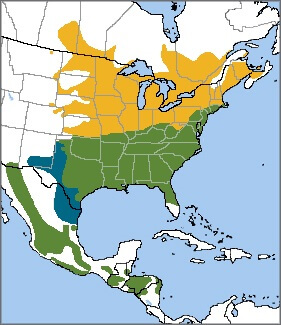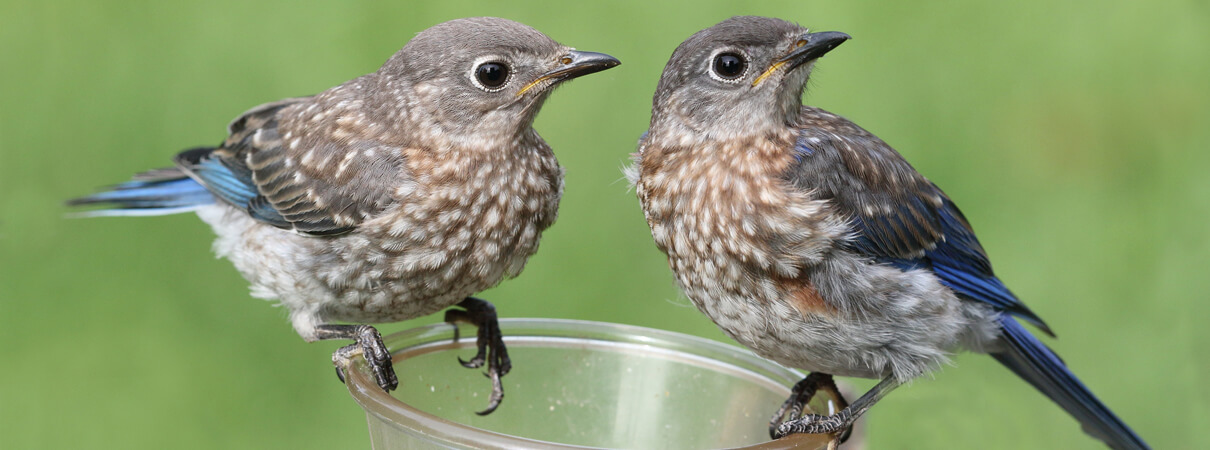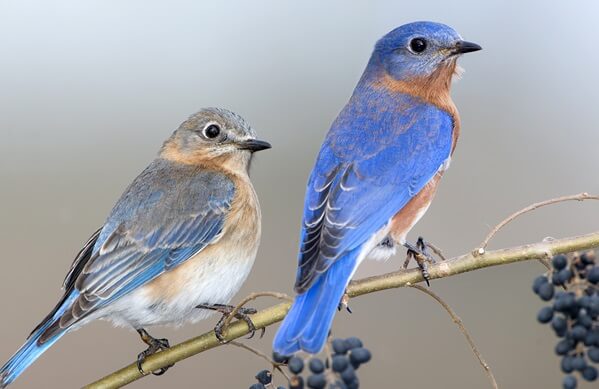 "The bluebird is well named, for he wears a coat of the purest, richest, and most gorgeous blue on back, wings, and tail; no North American bird better deserves the name, for no other flashes before our admiring eyes so much brilliant blue." — Arthur Cleveland Bent, Life Histories of Familiar North American Birds
"The bluebird is well named, for he wears a coat of the purest, richest, and most gorgeous blue on back, wings, and tail; no North American bird better deserves the name, for no other flashes before our admiring eyes so much brilliant blue." — Arthur Cleveland Bent, Life Histories of Familiar North American Birds
The vibrant colors and soft, musical warbles of the Eastern Bluebird are a welcome sight on a cold, snowy day. Bluebirds have long been considered harbingers of spring, and their willingness to nest in open, human-modified habitats makes them popular among birders and non-birders alike.
Bluebirds are featured in many popular songs and books, including the song "Somewhere Over the Rainbow" from the "Wizard of Oz." A fairy tale by Belgian playwright Maurice Maeterlinck, "The Blue Bird," introduced the term "Bluebird of Happiness" into popular culture. Like the Northern Cardinal, the bluebird's bright plumage makes it a popular motif on calendars, greeting cards, and other printed material.
This lovely species has made a heartening comeback since the early 20th century, when introduced species, habitat loss, and pesticides caused alarming population declines.
The Eastern Bluebird's genus, Silia, is part of the larger thrush family, making the bluebird a relative of the Wood Thrush, Bicknell's Thrush, and Swainson's Thrush. There are eight recognized subspecies of Eastern Bluebird, found in North America, Mexico, and Central America.
This species is a “partial migrant.” Some birds move south, and some stay near their nesting grounds, depending on weather and food availability. Cold winters are particularly hard on bluebirds and can cause high mortality rates. (Learn about best ways to help birds during a cold snap.)
Feeder Visitor
The Eastern Bluebird's diet is made up of insects such as crickets, grasshoppers, and beetles, with fruit added, especially during the winter. The birds hunt for insect prey using a "sit and wait" strategy, somewhat like a Willow Flycatcher. Once a bluebird spots prey, it drops down from its perch to snatch it from the air or the ground. Bluebirds also love mealworms, sunflower seeds, and suet, and will readily visit feeders for them.

Juvenile Eastern Bluebirds by Steve Byland, Shutterstock
Secondary Nesters
The Eastern Bluebird, like the Purple Martin and Flammulated Owl, is a "secondary" cavity-nesting species. Since their beaks and feet are not strong enough to dig out nesting holes, they simply re-use cavities created by bigger birds such as woodpeckers. Bluebirds will also accept artificial nest boxes, a habit which was instrumental in rescuing the species.
Male Eastern Bluebirds attract a female by taking nesting material to a potential nest site, going in and out of the cavity, and perching above it while waving their wings.
The female builds a nest of grasses, pine needles, hair, and other soft materials, where she lays her clutch of two to seven pale blue eggs. Bluebirds usually raise two broods per season. Both male and female, sometimes assisted by young birds from previous broods, help feed the nestlings.
Monogamous during the nesting season, Eastern Bluebirds are found in small flocks at other times of the year. Bluebirds use cavities or boxes as roosting as well as nesting sites. They will sometimes bundle together into a cavity as a group, particularly in cold weather.
A Little Human Help
Eastern Bluebird populations plunged in the early 20th century, when non-native House Sparrows and European Starlings were introduced into the United States. Both of these invasive species are also cavity-nesters and much more aggressive than bluebirds, so they quickly took over suitable nest cavities and habitats.
Fortunately, concerned citizens stepped in to halt bluebird declines. Organizations such as the North American Bluebird Society and Sialis have been instrumental in encouraging bluebird conservation through education, promotion of artificial nest boxes, and establishment of bluebird nest box trails, which are protected and monitored by a network of volunteers.
At ABC, we have continued work to protect the Eastern Bluebird and other species from the effects of pesticides, particularly lethal varieties such as chlorpyrifos and neonicotinoids. Other ABC policy programs, including Cats Indoors and glass collisions, recommend measures to benefit bluebirds and many other bird species.



















































